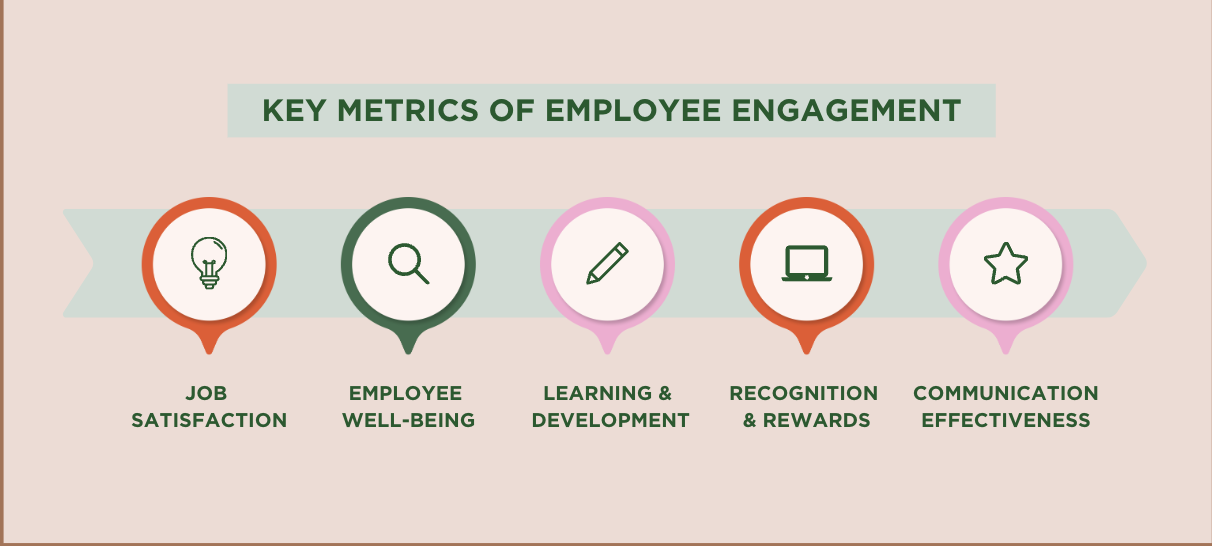Identifying Key Employee Engagement Metrics
Employee engagement is a key factor influencing productivity and retention. Metrics like the Employee Net Promoter Score (eNPS) provide insights into the likelihood of employees recommending their workplace to others. Pulse Surveys, conducted at regular intervals, offer real-time feedback, enabling organizations to address concerns promptly.
Engaged employees are more likely to stay, contribute discretionary effort, and recommend their company to others.” – Harvard Business Review
Assessing Well-being and Work-Life Balance
As organizations recognize the importance of employee well-being, measuring mental health metrics has become essential. Work-life balance is no longer a luxury but a necessity, and evaluating this balance contributes to a positive employee experience.
Measuring Career Development Opportunities
Employees seek growth and development. Metrics related to training programs, skill enhancement, and advancement opportunities provide a quantifiable way to assess an organization’s commitment to employee growth.
Google’s “20% time” policy, allowing employees to dedicate a portion of their workweek to personal projects, has led to innovations such as Gmail and Google News.
Evaluating Manager-Employee Relationships
The relationship between employees and their supervisors can significantly impact job satisfaction. Metrics assessing leadership effectiveness, communication, and support systems help in understanding and improving this crucial aspect of employee experience.
Considering Inclusivity and Diversity Metrics
A diverse and inclusive workplace fosters a sense of belonging. Metrics related to diversity and inclusion initiatives, coupled with measures of employees’ sense of belonging, offer insights into the inclusivity of an organization.
Assessing Technology and Tools Impact
In the digital age, technology plays a pivotal role in the workplace. Metrics evaluating the impact of technology on day-to-day operations and employee experience help organizations stay ahead in providing a technologically adept environment.
Measuring Employee Recognition and Appreciation
Salesforce’s recognition program increased employee engagement by 34% and reduced turnover.
Recognition and appreciation are powerful motivators. Metrics assessing the effectiveness of recognition programs and their impact on employee motivation contribute to a positive employee experience.
Quantifying Alignment with Company Values
Example: Patagonia’s commitment to environmental sustainability resonates with employees, leading to a strong sense of purpose and commitment.
When employees align with organizational values, a sense of purpose emerges. Metrics evaluating alignment help organizations understand how well their values resonate with employees, influencing engagement and commitment.
Understanding Turnover and Retention Metrics
The cost of replacing an employee can range from 16% of their annual salary for low-skilled positions to 213% for executives.
High turnover can be detrimental to organizational success. Metrics identifying potential issues leading to turnover and strategies for improving retention are critical for maintaining a stable and satisfied workforce.
Analysing Flexibility and Remote Work Metrics
The mention of metrics related to flexibility and remote work effectiveness suggests a strategic approach towards managing remote work. Organizations are now focusing on quantifiable measures to evaluate the success of remote work arrangements. Metrics could include factors like employee satisfaction, productivity levels, and the ability to meet deadlines. By analyzing these metrics, companies can gain insights into how well their remote work policies are functioning and identify areas for improvement.
Balancing employee needs with overall productivity is a crucial aspect discussed in the paragraph. It acknowledges the importance of creating a work environment that meets the needs of employees while ensuring that the organization continues to operate efficiently. This balance requires a thoughtful consideration of factors like flexible working hours, access to necessary resources, and effective communication tools.
Metrics for Team Collaboration and Communication
Effective teamwork and communication are fundamental to a positive employee experience. Metrics evaluating team dynamics, collaboration tools, and communication channels help organizations create an environment conducive to collaboration.
Evolving Trends in Employee Experience Measurement
As technology continues to advance, the landscape of measuring employee experience undergoes a transformation, reflecting a dynamic shift in methodologies. The integration of advanced analytics and predictive tools has become instrumental in enabling organizations to proactively navigate and improve the overall employee journey.
In the realm of employee experience measurement, emerging trends highlight a departure from traditional approaches towards more sophisticated, data-driven methodologies. The evolution of technology plays a pivotal role, offering a plethora of tools that transcend basic assessments. Organizations now harness advanced analytics to glean deeper insights into various facets of the employee experience. This analytical prowess facilitates the identification of patterns, trends, and potential issues before they escalate, allowing proactive intervention.
Predictive tools further elevate the employee experience measurement landscape by forecasting potential challenges and opportunities. By leveraging data-driven predictions, organizations can strategically allocate resources, implement targeted interventions, and tailor employee engagement initiatives. This forward-looking approach is a significant departure from reactive strategies, fostering a more adaptive and responsive organizational culture.
In essence, the evolving trends in employee experience measurement underscore a paradigm shift towards a proactive, data-driven, and technologically infused approach. This evolution not only enhances the organization’s ability to address issues promptly but also contributes to an enriched and optimized overall employee journey.
Conclusion
Data-driven insights provide the foundation for the future of HR and employee experience.” – Josh Bersin, HR Thought Leader
In conclusion, measuring the intangible aspects of employee experience is crucial for creating a workplace where individuals thrive. From understanding satisfaction and engagement to evaluating inclusivity, technology impact, and evolving trends, organizations must adopt a holistic approach to employee experience measurement.


